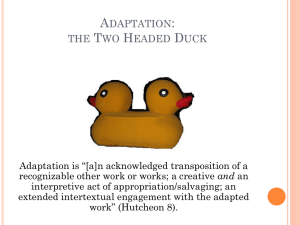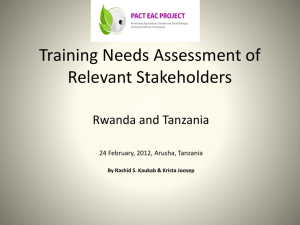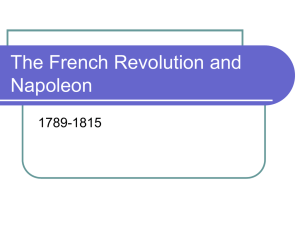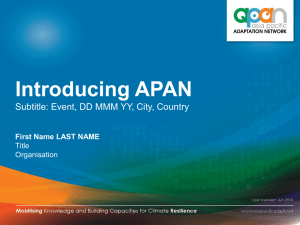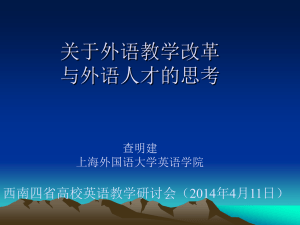Stocktaking for National Adaptation Planning (SNAP) - UNDP-ALM
advertisement
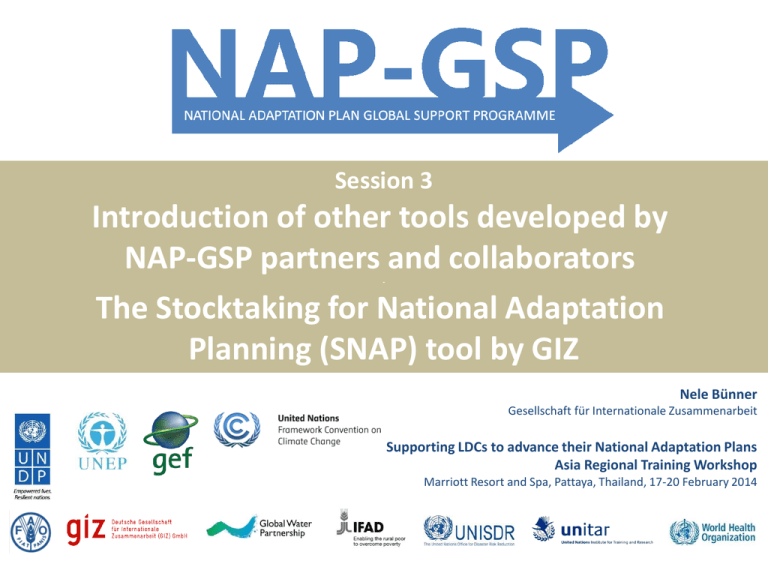
Session 3 Introduction of other tools developed by NAP-GSP partners and collaborators The Stocktaking for National Adaptation Planning (SNAP) tool by GIZ - Nele Bünner Gesellschaft für Internationale Zusammenarbeit Supporting LDCs to advance their National Adaptation Plans Asia Regional Training Workshop Marriott Resort and Spa, Pattaya, Thailand, 17-20 February 2014 NAP process (5/CP.17) • Objectives Reduce vulnerability, build adaptive capacity and resilience Mainstream adaptation to climate change into all relevant sectorspecific and general development planning • Characteristics Country-driven, non-prescriptive, iterative, building on existing efforts Transparent, participatory, gender-sensitive • Elements a) Laying the groundwork and addressing gaps b) Preparatory elements c) Implementation Strategies d) Monitoring, reporting, review Session 3 Introduction of tools developed by NAP-GSP partners and collaborators Supporting LDCs to advance their National Adaptation Plans Asia Regional Training Workshop Elements of the NAP process GIZ Stocktaking tool for identifying needs, gaps, and the point of departure for the NAP process Session 3 Introduction of tools developed by NAP-GSP partners and collaborators Source: LEG 2012 Supporting LDCs to advance their National Adaptation Plans Asia Regional Training Workshop Stocktaking for National Adaptation Planning (SNAP) tool Mainly support for Element A: Lay the groundwork and address gaps Initiate of the NAP process Assesses on-going and past adaptation activities Assesses of strategic NAP goals Identify needs and gaps Based on 7 success factors for NAP (21 test questions) Entry points for additional measures Monitoring & Evaluation of national planning process Session 3 Introduction of tools developed by NAP-GSP partners and collaborators Supporting LDCs to advance their National Adaptation Plans Asia Regional Training Workshop UNFCCC guidance on NAP success factors Success factor UNFCCC guidance Climate information “Guided by the best available science and, as appropriate, traditional knowledge” (5/CP.17, 3rd para) Human and institutional capacities “Institutional arrangements and capacities for overall coordination and leadership on adaptation“ (5/CP.17, Annex, 2nd para) Long term vision and mandate “Identify and address medium- and long-term adaptation needs” (1/CP.16, 15th para) Implementation “Based on nationally identified priorities” (5/CP.17, 1st para) Mainstreaming „Integrate adaptation to climate change into all sector-specific and general development planning” (5/CP.17, 1st para) Participation “Gender-sensitive, participatory and fully transparent approach” (5/CP.17, 3rd para) M&E “Address inefficiencies; reflect lessons learned; monitor and review efforts; report on effectiveness” (5/CP.17, Annex, 6th para) Session 3 Introduction of tools developed by NAP-GSP partners and collaborators Supporting LDCs to advance their National Adaptation Plans Asia Regional Training Workshop Climate information Data about climate impacts, vulnerabilities and adaptation options that provide the basis for solid decision making about responses to climate change. Picture: Inventory of Methods for Adaptation to Climate Change (IMACC) Session 3 Introduction of tools developed by NAP-GSP partners and collaborators Supporting LDCs to advance their National Adaptation Plans Asia Regional Training Workshop Human and institutional capacities The ability of stakeholders and institutions to coordinate adaptation processes as well as to use and manage climate information. Session 3 Introduction of tools developed by NAP-GSP partners and collaborators Supporting LDCs to advance their National Adaptation Plans Asia Regional Training Workshop Long term vision and mandate Common understanding on long term objectives for national development taking climate change into account, as well as a mandate to align key process with this vision. Picture: Inventory of Methods for Adaptation to Climate Change (IMACC) Session 3 Introduction of tools developed by NAP-GSP partners and collaborators Supporting LDCs to advance their National Adaptation Plans Asia Regional Training Workshop Implementation The quality, quantity and strategic orientation of measures that are put on the ground to enhance resilience or reduce vulnerability to changes in climate. Picture: Inventory of Methods for Adaptation to Climate Change (IMACC) Session 3 Introduction of tools developed by NAP-GSP partners and collaborators Supporting LDCs to advance their National Adaptation Plans Asia Regional Training Workshop Mainstreaming The process of integrating adaptation into development processes at all planning levels, including national, sectorial and communal policy documents and programs. Picture: Inventory of Methods for Adaptation to Climate Change (IMACC) Session 3 Introduction of tools developed by NAP-GSP partners and collaborators Supporting LDCs to advance their National Adaptation Plans Asia Regional Training Workshop Participation The involvement of representatives from private entities, different sectorial public administrations, civil society and NGO. Involving women´s representatives is especially important since women are often disproportionally affected by climate change. Picture: Inventory of Methods for Adaptation to Climate Change (IMACC) Session 3 Introduction of tools developed by NAP-GSP partners and collaborators Supporting LDCs to advance their National Adaptation Plans Asia Regional Training Workshop Monitoring & Evaluation (M&E) Monitoring climate change impacts, financial resources, and adaptation performance, as well as monitoring and evaluating adaptation results provides valuable information for adaptation planning and decision-making. M&E systems for adaptation ensure effective resource allocation, improve accountability, strengthen steering adaptation plans and activities and foster learning on adaptation. Picture: Inventory of Methods for Adaptation to Climate Change (IMACC) Session 3 Introduction of tools developed by NAP-GSP partners and collaborators Supporting LDCs to advance their National Adaptation Plans Asia Regional Training Workshop How to assess these factors? • Participatory stakeholder workshop (1-2 days) • Introduction to NAP • Overview of the national adaptation and development planning context • Combination of group discussion and individual assessment with qualitative justification for current and intended planning capacities • Group discussion on results • Documentation of assessment results and discussion Session 3 Introduction of tools developed by NAP-GSP partners and collaborators Supporting LDCs to advance their National Adaptation Plans Asia Regional Training Workshop Results • Common understanding of point of departure in the NAP process • Exchange between important institutions • Meaning of NAP for the country • Identification of important needs and gaps for effective adaptation • Indications for formulating a NAP ‘roadmap’ – Prioritize success factors – Specific activities Session 3 Introduction of tools developed by NAP-GSP partners and collaborators Supporting LDCs to advance their National Adaptation Plans Asia Regional Training Workshop Training on Stocktaking for National Adaptation Planning (SNAP) tool by GIZ Adapted version for training context: • Introduction to the SNAP tool • Simulation of a national stakeholder workshop using the SNAP tool • Findings and wrap-up • Presentation of real-case application in Tunisia Material Session 3 Introduction of tools developed by NAP-GSP partners and collaborators Supporting LDCs to advance their National Adaptation Plans Asia Regional Training Workshop Thursday, 11.45 am to 1.45 pm Training session on the Stocktaking for National Adaptation Planning (SNAP) tool by GIZ Contact: Nele Bünner, nele.buenner@giz.de Session 3 Introduction of tools developed by NAP-GSP partners and collaborators Supporting LDCs to advance their National Adaptation Plans Asia Regional Training Workshop

